The Supermicro X10SDV-4C-TLN4F is a low power mITX platform and the first in our lab with the new Intel Xeon D-1518. The Intel Xeon D-1518 is a 4 core / 8 thread CPU that sports a 2.2GHz clock speed and a low 35w TDP. This is our first Intel Xeon D “wave 2” review of a platform with the Xeon D chips launched November 2015 and as a D-15×8 series part it is a networking SKU. We have reviewed the base X10SDV platform numerous times, most recently with the Supermicro X10SDV-4C-TLN2F review in mid-2015. Even with only one digit difference in the model names (-TLN2F v. -TLN4F), this new motherboard adds a lower TDP “wave 2” Xeon D with features like Intel DPDK support and an additional pair of 1Gb Ethernet NICs. We actually use four of the 8-core Intel Xeon D-1540 based Supermicro X10SDV-TLN4F to host STH and related sites so we have a fair amount of experience with this platform.
Test Configuration
We used a similar configuration as to the one we used on other X10SDV platforms we have reviewed.
- CPU: Intel Xeon D-1518 (embedded)
- Motherboard: Supermicro X10SDV-4C-TLN4F
- Memory: 128GB – 4x Samsung 32GB DDR4 2133MHz ECC RDIMMs
- SSD: 6x Intel DC S3700 400GB, 1x Samsung XP941 512GB, 1x Intel DC P3600 400GB(add-in HHHL card)
- Operating Systems: Ubuntu 14.04 LTS, Windows Server 2012 R2, CentOS 7, OpenSUSE 13.2
We purposefully loaded up the system with SSDs just to ensure that all slots would operate if populated with storage. Production builds we are using in our datacenters typically have a SATA DOM, 4x 960GB SSDs and either 64 or 128GB of RAM.
Supermicro X10SDV-4C-TLN4F Overview
Following the familiar X10SDV layout, this motherboard comes in a compact mITX form factor. Primary features from the Xeon D SoC remain intact.
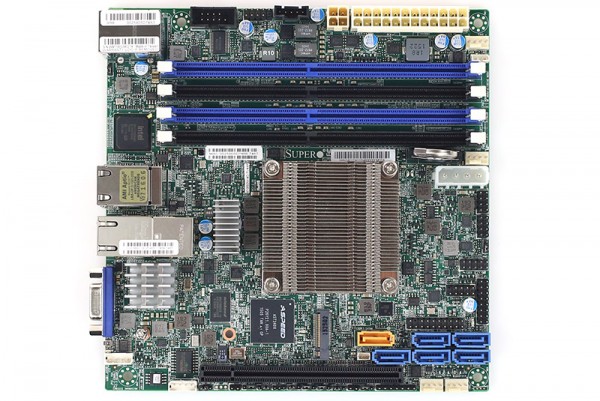
One will quickly notice that this motherboard is passively cooled. With the 35w TDP SoC onboard, the platform will still need chassis cooling. We have thermal imaging below which can show there are other hot spots on the motherboard. The components are laid out for standard front to back airflow design in most 1U cases. The Intel Xeon D-1518 is a 2.2GHz clock part with 6MB L3 cache. While it does support VT-d, DPDK, AES-NI, Hyper-Threading and other standard features, it does not feature Turbo Boost so the base clock of 2.2GHz is as high as it will go.
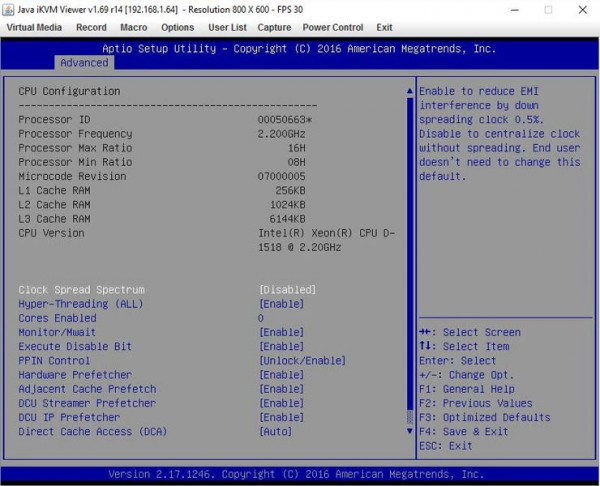
You can see our Intel Xeon D-1518 Linux benchmark results for full performance figures but suffice to say, it performs nicely compared to other lower power platforms.
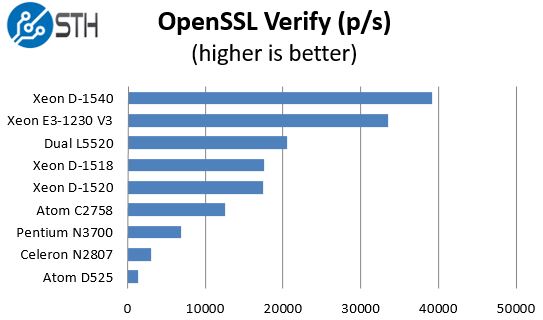
Looking to the top edge of the motherboard we see standard power connectors. We were able to power our test system using only the 24-pin ATX power connector. In a short depth 1U chassis, one can have solid system even in lower power density 1A @ 110V / 1U racks because the base platform consumes under 60w. Add in fans, RAM and a few SSDs and the platform can still run well under 1A at 110V or 120V.
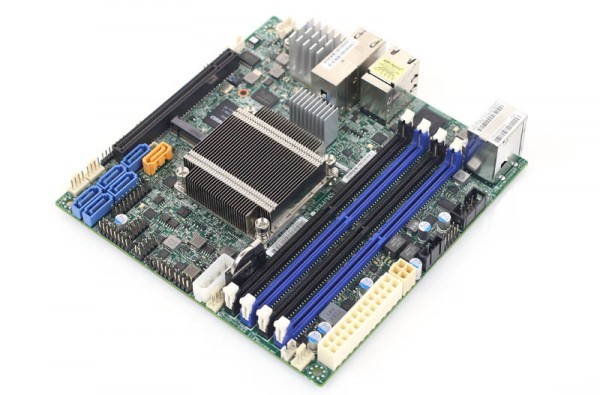
There are only three 4-pin PWM power connectors. This is certainly not a lot, but it does provide enough headers to give the platform the minimal airflow it requires.
One can see that the motherboard has a m.2 PCIe 3.0 x4 slot for SSDs. A m.2 SSD that is in this slot will sit just above the Aspeed AST2400 BMC chip which generates a fair amount of heat itself. That is a product of the PCB being so cramped with components. We would have liked to have seen a second m.2 slot for a RAID 1 SSD.
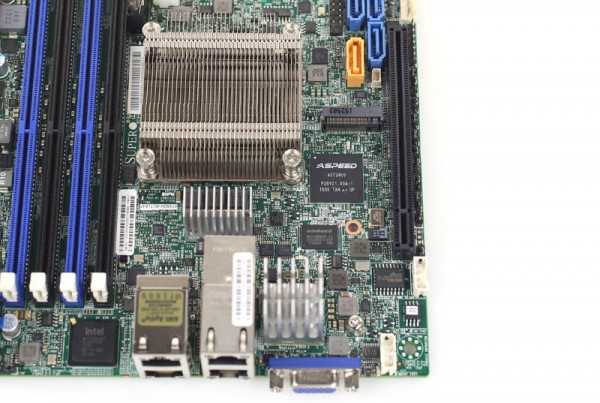
The Intel Xeon D platform has a set of PCIe 3.0 x16 lanes that is directed at the PCIe x16 slot onboard the X10SDV-4C-TLN4F. From our experience, one can actually get two NVMe SSDs to work in this slot using the Supermicro AOC-SLG3-2E4 card. Please note, you will need the Avago/ PLX chip version for this to work so the less expensive “R” version of the card will not work. See the linked thread for more information.
There are six onboard SATA III 6.0gbps ports. One of these ports (orange) is designed to take a SATA DOM. We use the 64GB SATA DOM quite extensively in our Xeon D 1U builds simply to save space. One can see our typical parts list here for the CSE-505-203B builds we use.
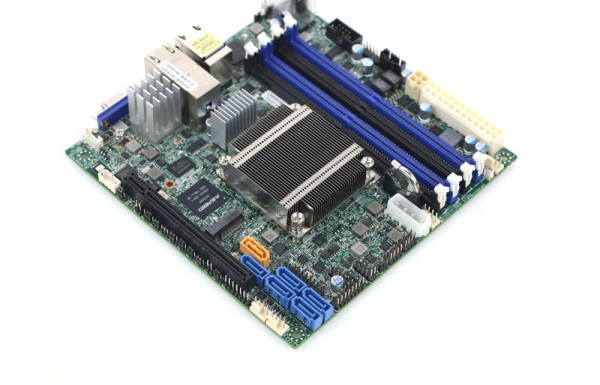
Omitted from the motherboard is a Type-A USB header. Then again, there is virtually no space for this on the PCB. This is a commonly used feature for embedded OSes such as those for storage appliances. One looking to install an embedded OS should look to the SATA DOM solution instead.
Moving to the rear of the unit one can see two USB 3.0 ports below the IPMI remote management Ethernet port.We see four RJ-45 ports which are the Xeon D’s two 10Gbase-T Ethernet ports and two 1GbE ports. The 10Gbase-T PHY for this is is under the large heatsink and in front of the VGA port. The Intel i350 controller for the dual 1GbE ports is a higher-end solution than dual i210-at controllers. The chip can be seen next to the DDR4 DIMM slots as well as the dual 1GbE RJ-45 ports.
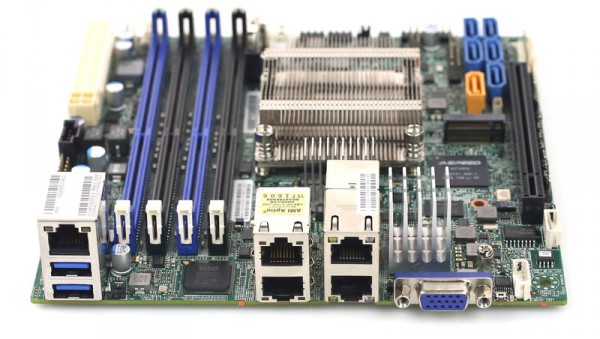
Overall the hardware packed on this small motherboard is impressive. One can build a very complete and expandable system in a short depth 1U chassis. It is possible to have a dual 10Gbase-T Ceph storage node with a m.2 boot drive, six 4TB SATA SSDs and stay under 1A at 110V.
Supermicro X10SDV-4C-TLN4F Thermal Imaging and Power Consumption
To capture these images we utilize our FLIR Ex series professional thermal imaging camera and turn on FLIR’s MSX enhancements so we can see components outlined clearly. We put the system under 100% CPU load for a period of 24 hours to let “heat soak” set in prior to taking the images. Here is a shot in our standard 22C to 60C range with the FLIR MSX overlay.
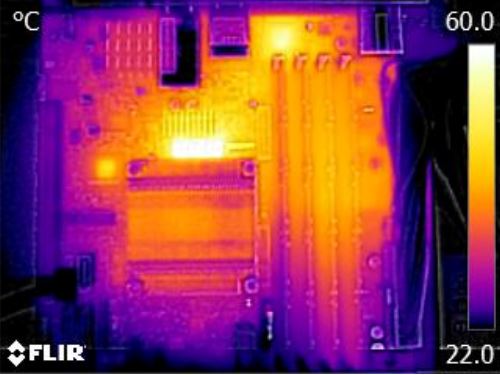
We can see the key hot spots being the AST2400 controller, the 10Gbase-T PHY and the power delivery components to the Xeon D-1518 SoC. We are using relatively low power cooling for this that is measuring around 24dba so one could certainly get cooler temps running higher speed fans.
We used our Extech TrueRMS Power Analyzer 380803 to take measurements at different points of the board’s use.
- BMC only power off – 4.8w
- Ubuntu 14.04 LTS installation screen – 22.3w
- UnixBench 5.1.3 single thread max – 31.1w
- Multi threaded max observed – 57.2w
These results are excellent with the new 35w TDP part showing great performance. If one is careful to select the right power and cooling, these platforms are just about able to fit two systems in a 1A @ 120V lower power density rack with two SSDs.
Supermicro Management
Supermicro’s IPMI and KVM-over-IP as described a few times on this site, allows for a lot of deployment flexibility. Things such as fan speeds, chassis intrusion sensors, thermal sensors, and etc. can be monitored remotely. Alerts can be setup to notify the admins of issues. Beyond this, the functionality also allows for remote power control. One can do remote power up, power down, and reset of the server in the event that it becomes unresponsive.
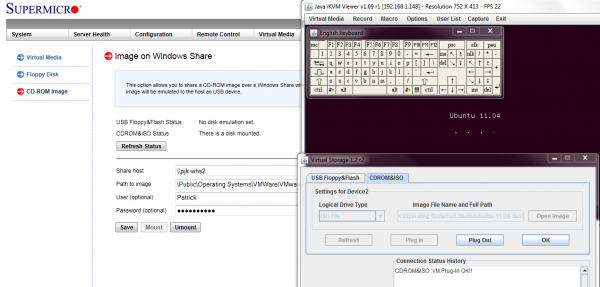
Another important feature is the ability to remotely mount CD images and floppy images to the machine over the dedicated management Ethernet controller. This keeps maintenance traffic off of the primary Intel NICs. At the same time it removes the need for an optical disk to be connected to the Supermicro motherboard.
The latest revision of Supermicro’s BIOS has a great feature: the BMC IP address shows up on the post screen! This is a super feature because if one has a KVM cart hooked up to the system, it gives an indicator of which machine one is connected to during post.

Supermicro does include KVM-over-IP functionality with the motherboard. We have been testing servers from HP, Dell, Lenovo and Intel that all required an additional add-in key to get this functionality. It is an absolute time and money saver in the datacenter and other vendors should follow Supermicro’s lead in this space.
Conclusion
With the Supermicro X10SDV-4C-TLN4F we have a top contender for a low power platform. Comparing this to just the alternative for the onboard Intel X557 dual 10Gb controller, an Intel X540-t2 dual port 10Gbase-T adapter costs over $300 new. Or a low end 4 core/ 8 thread Xeon E3-1200 V5 chip plus motherboard is probably $350-400. From a value perspective, if the 4 cores and 8 threads at 2.2GHz is enough for you, this is an extremely strong and low power 10Gbase-T platform. We do not have final pricing for this yet, but based on our experience with other X10SDV motherboards, we expect street pricing in the $500-550 range. Add 64GB (4x 16GB DDR4 RDIMMs) of RAM and two SSDs and you will have a great cluster node in the $1200-$1400 range.

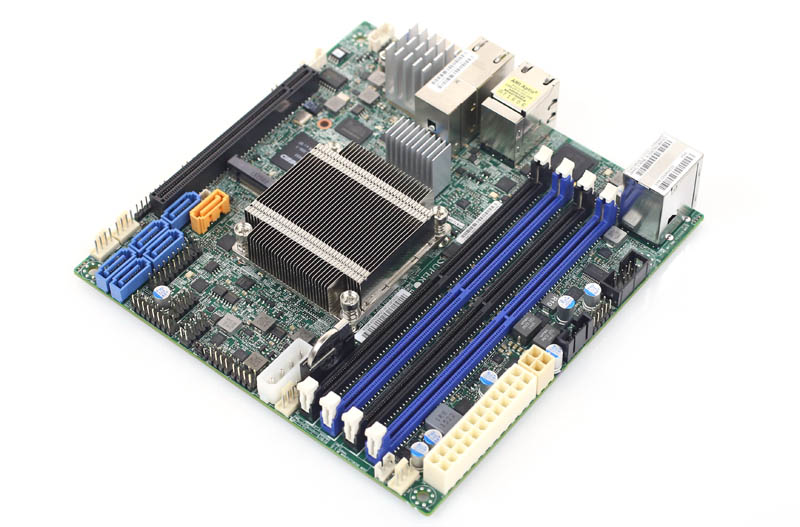



I have 2 questions about these Supermicro Xeon D boards if you don’t mind:
1) Will Ubuntu 14.04 need any extra drivers to make these boards fully compatible with 14.04? Maybe i remember wrong but i think i recall someone saying you need drivers for the X557 to get them to work on 14.04? If so, if we ignore 15.10, we will have to wait for 16.04 to get native drivers for these boards in Ubuntu?
2) What about raid, or rather, fakeRAID, i looked at the manual for the Xeon D boars on Supermicros site and a couple of reviews about the boards release so far but no one really mentions anything about raid. The only time the manual mention raid is this:
“Select RAID to configure a SATA drive specified by the user as a RAID drive. The options are IDE, AHCI, and RAID. ”
So the boards seem to support fakeRAID? But which level? 0, 1, 5 or even 10? Would really appreciate if you could clarify this
You can use 14.04.3 or download and use the newest Intel ixgbe driver.
On the RAID side, you can do 0, 1, 5 and 10, however, I would strongly recommend using software RAID if you can.
I’m planing to build a mini home NAS with with 4×2.5″ drives in a streacom F7C Alpha case. The system wouldn’t have a high load, mostly idle.
Is one 92mm chassis fan enough (NOCTUA NF-A9 PWM)?
The fan is on the left side (viewed from the back I/O shield).
The DIMMs are in the way of the airflow to the passive cpu cooler and the cooler has not the optimal orientation.
– Can the cooler be rotated by 90 degree?
– Is it better install a CPU cooler?
Hi Patrick,
Very nice and informative article on the Supermicro X10SDV-4C-TLN4F board. Are you absolutely certain that the new Xeon D-1518 processor has built-in support for Intel QuickAssist. The reason I ask is that there is no information about QuickAssist on the Xeon D-1518 product page or on the Xeon Processor D-1500 Family pages.
Kind regards,
Ole Willy Tuv
Hi,
The Xeon D does not have an onboard QAT accelerator so you need a Coleto Creek QAT PCIe card for Quick Assist with this generation.
Regards,
Patrick
Thanks for the information.
I guess this means that the A1SRi-2758F board would be a superior option for a dedicated pfSense configuration?
– A lot cheaper than Xeon D-15×8 configurations
– Onboard QuickAssist accelerator
– 20W CPU with passive cooling
– Planned support for QA in pfSense during 2016
Ole